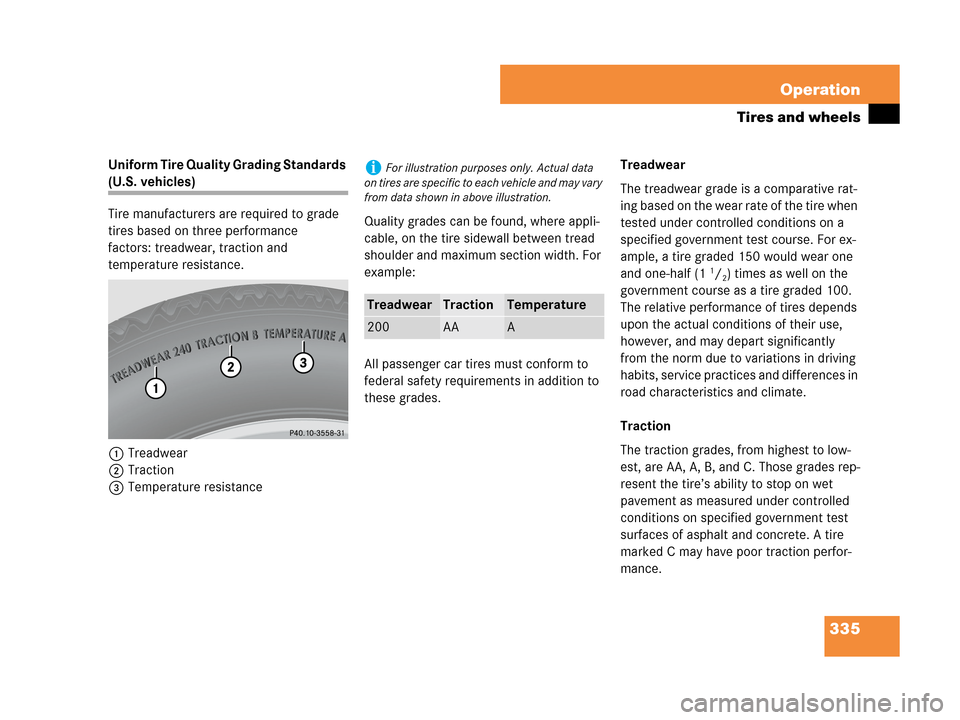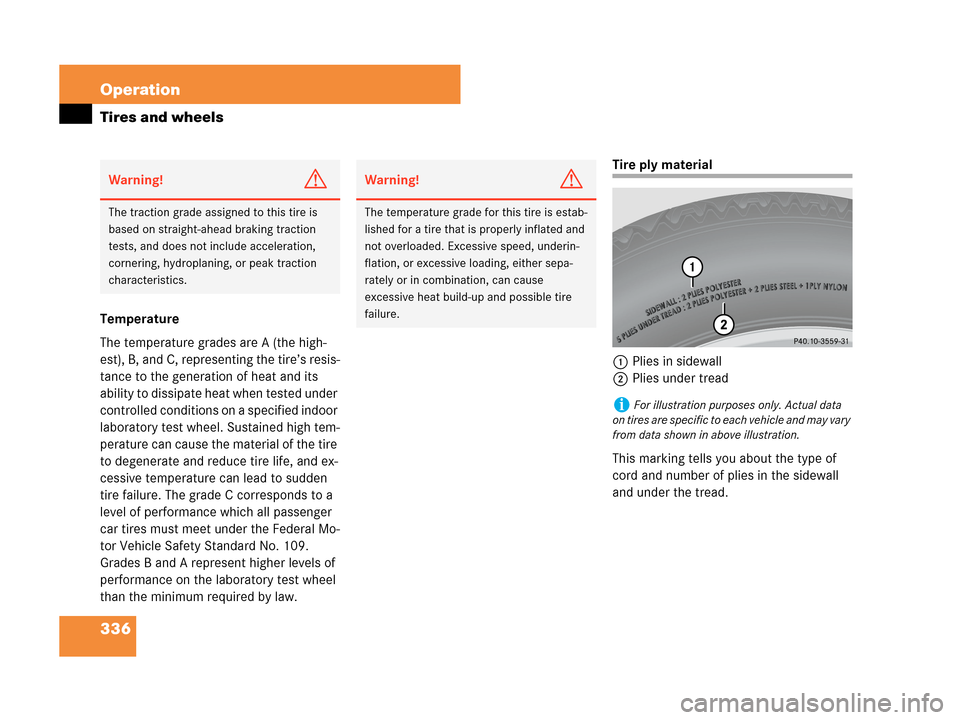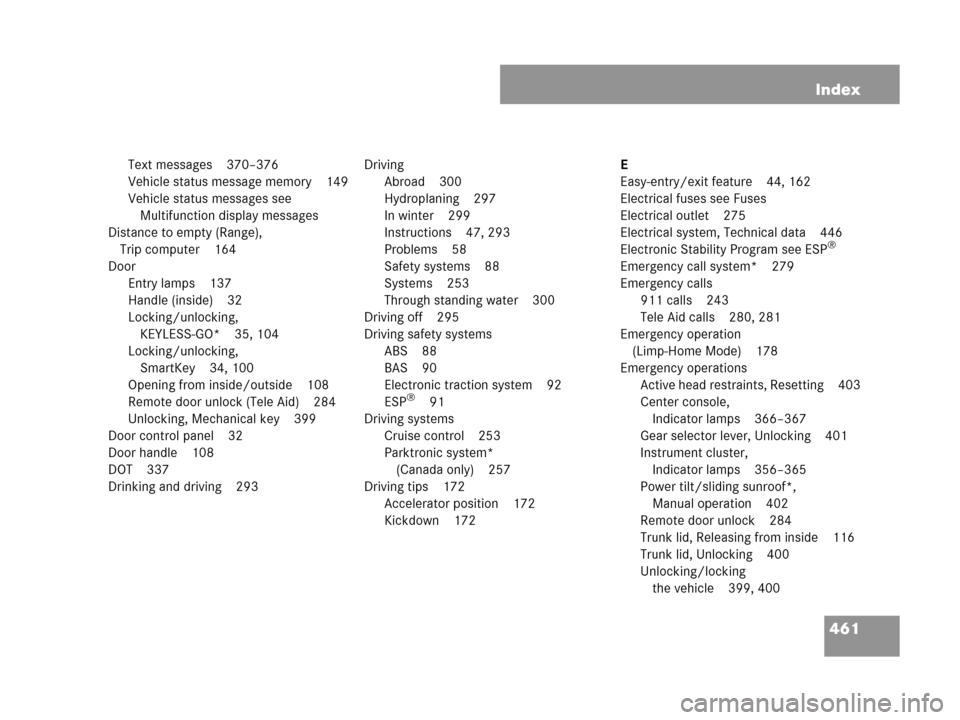Page 336 of 481

335 Operation
Tires and wheels
Uniform Tire Quality Grading Standards
(U.S. vehicles)
Tire manufacturers are required to grade
tires based on three performance
factors: treadwear, traction and
temperature resistance.
1Treadwear
2Traction
3Temperature resistanceQuality grades can be found, where appli-
cable, on the tire sidewall between tread
shoulder and maximum section width. For
example:
All passenger car tires must conform to
federal safety requirements in addition to
these grades.Treadwear
The treadwear grade is a comparative rat-
ing based on the wear rate of the tire when
tested under controlled conditions on a
specified government test course. For ex-
ample, a tire graded 150 would wear one
and one-half (1
1/2) times as well on the
government course as a tire graded 100.
The relative performance of tires depends
upon the actual conditions of their use,
however, and may depart significantly
from the norm due to variations in driving
habits, service practices and differences in
road characteristics and climate.
Traction
The traction grades, from highest to low-
est, are AA, A, B, and C. Those grades rep-
resent the tire’s ability to stop on wet
pavement as measured under controlled
conditions on specified government test
surfaces of asphalt and concrete. A tire
marked C may have poor traction perfor-
mance.
iFor illustration purposes only. Actual data
on tires are specific to each vehicle and may vary
from data shown in above illustration.
TreadwearTractionTemperature
200AAA
Page 337 of 481

336 Operation
Tires and wheels
Temperature
The temperature grades are A (the high-
est), B, and C, representing the tire’s resis-
tance to the generation of heat and its
ability to dissipate heat when tested under
controlled conditions on a specified indoor
laboratory test wheel. Sustained high tem-
perature can cause the material of the tire
to degenerate and reduce tire life, and ex-
cessive temperature can lead to sudden
tire failure. The grade C corresponds to a
level of performance which all passenger
car tires must meet under the Federal Mo-
tor Vehicle Safety Standard No. 109.
Grades B and A represent higher levels of
performance on the laboratory test wheel
than the minimum required by law.
Tire ply material
1Plies in sidewall
2Plies under tread
This marking tells you about the type of
cord and number of plies in the sidewall
and under the tread.
Warning!G
The traction grade assigned to this tire is
based on straight-ahead braking traction
tests, and does not include acceleration,
cornering, hydroplaning, or peak traction
characteristics.
Warning!G
The temperature grade for this tire is estab-
lished for a tire that is properly inflated and
not overloaded. Excessive speed, underin-
flation, or excessive loading, either sepa-
rately or in combination, can cause
excessive heat build-up and possible tire
failure.
iFor illustration purposes only. Actual data
on tires are specific to each vehicle and may vary
from data shown in above illustration.
Page 363 of 481

362 Practical hints
What to do if …?
ProblemPossible cause/consequenceSuggested solution
vThe yellow ESP® warn-
ing lamp comes on while
the engine is running.The ESP® has been switched off with the
ESP® switch or has been switched off due
to a malfunction.
Risk of accident!
When the ESP
® is switched off it will not
stabilize the vehicle if the system recog-
nizes that the vehicle starts to skid or that
a wheel is spinning.
The cruise control is deactivated and can-
not be switched on.
�Switch the ESP® back on (�page 93).
Exceptions: (
�page 92).
�If leaving the ESP® switched off, adapt your speed
and driving to the prevailing road, weather and
traffic conditions.
If the ESP
® cannot be switched on:
�Continue driving with added caution.
�Observer additional messages that may appear in
the multifunction display (
�page 370).
�Have the system checked at an authorized
Mercedes-Benz Center as soon as possible.
vThe yellow ESP® warn-
ing lamp flashes while
driving.The ESP® or traction control has come
into operation because of detected trac-
tion loss in at least one tire.
The cruise control is deactivated�When driving off, apply as little throttle as possi-
ble.
�While driving, ease up on the accelerator.
�Adapt your speed and driving to the prevailing
road, weather and traffic conditions.
�Do not deactivate the ESP®.
Exceptions: (
�page 92).
Failure to follow these instructions increases the risk
of an accident.
Page 462 of 481

461 Index
Text messages 370–376
Vehicle status message memory 149
Vehicle status messages see
Multifunction display messages
Distance to empty (Range),
Trip computer 164
Door
Entry lamps 137
Handle (inside) 32
Locking/unlocking,
KEYLESS-GO* 35, 104
Locking/unlocking,
SmartKey 34, 100
Opening from inside/outside 108
Remote door unlock (Tele Aid) 284
Unlocking, Mechanical key 399
Door control panel 32
Door handle 108
DOT 337
Drinking and driving 293Driving
Abroad 300
Hydroplaning 297
In winter 299
Instructions 47, 293
Problems 58
Safety systems 88
Systems 253
Through standing water 300
Driving off 295
Driving safety systems
ABS 88
BAS 90
Electronic traction system 92
ESP
®91
Driving systems
Cruise control 253
Parktronic system*
(Canada only) 257
Driving tips 172
Accelerator position 172
Kickdown 172E
Easy-entry/exit feature 44, 162
Electrical fuses see Fuses
Electrical outlet 275
Electrical system, Technical data 446
Electronic Stability Program see ESP
®
Emergency call system* 279
Emergency calls
911 calls 243
Tele Aid calls 280, 281
Emergency operation
(Limp-Home Mode) 178
Emergency operations
Active head restraints, Resetting 403
Center console,
Indicator lamps 366–367
Gear selector lever, Unlocking 401
Instrument cluster,
Indicator lamps 356–365
Power tilt/sliding sunroof*,
Manual operation 402
Remote door unlock 284
Trunk lid, Releasing from inside 116
Trunk lid, Unlocking 400
Unlocking/locking
the vehicle 399, 400